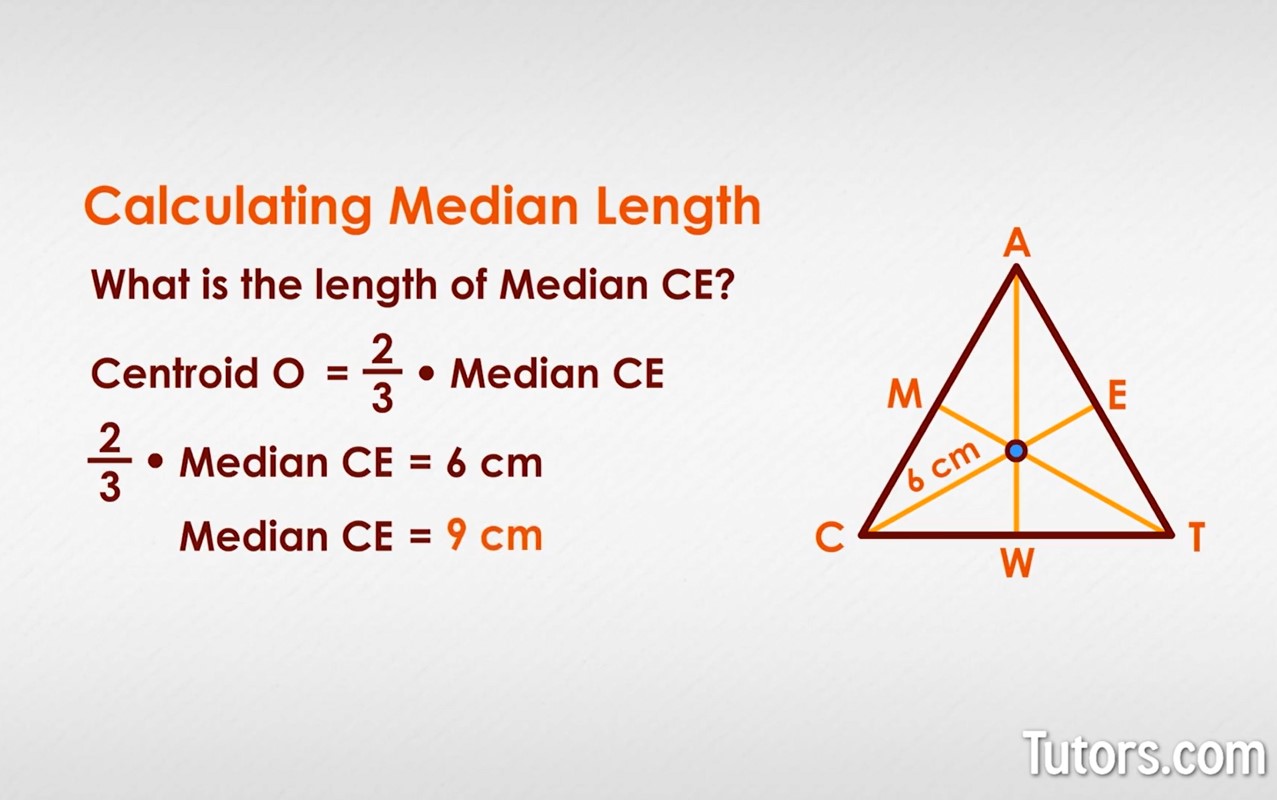How to Find the Centroid of a Triangle — Definition & Formula
Centroid of a triangle
Every triangle has a single point somewhere near its "middle" that allows the triangle to balance perfectly, if the triangle is made from a rigid material. The centroid of a triangle is that balancing point, created by the intersection of the three medians.
If the triangle were cut out of some uniformly dense material, such as sturdy cardboard, sheet metal, or plywood, the centroid would be the spot where the triangle would balance on the tip of your finger.
Centroids may sound like big rocks from outer space, but they are actually important features of triangles. They also have applications to aeronautics, since they relate to the center of gravity (CG) of shapes.
Median of a triangle
The median of a triangle is the line segment created by joining one vertex to the midpoint of the opposite side, like this:

Since every triangle has three sides and three angles, it has three medians.
How to find the centroid
To find the centroid of any triangle, construct line segments from the vertices of the interior angles of the triangle to the midpoints of their opposite sides. These line segments are the medians. Their intersection is the centroid.
The centroid has an interesting property besides being a balancing point for the triangle. It is always of the way from the vertex along the median, which means it is also of the way from the midpoint of the side. This is true for every triangle.
Another way to think of this breaking up of the median is to notice it is a ratio of , with the 2 always being the part from interior angle to centroid, and the 1 always being the distance from centroid to midpoint of a side.
Calculating median lengths
Here is with medians AW, TM, and CE. We know that the centroid, Point O, is at this exact location:
of the distance along each median from interior angles C, A, and T
of the distance along the median from the midpoint of sides CA, AT, and CT

If we know that the centroid is 6 cm from interior angle C, what is the length of median CE?
If we know that centroid O is of the way along median AW, and is 7.5 cm from interior angle A, how long is median AW?
Think: 7.5 is of what number?
Did you say 11.25 cm? We hope so, because that is the correct answer!
Finding the centroid's location
Now that you know the centroid must be of the median's distance from an interior angle, you can find the centroid of any triangle using only one median!
Here is , with only one median, OF, constructed by locating Point F exactly halfway along DG. Median OF is 36 cm long.
Since you know the centroid is of the distance along OF, you can measure of 36 cm, or 24 cm, along OF to find the centroid.

Now you give it a go! Suppose you know median DU is 18 cm; how far along it will be the centroid?
We hope you said 12 cm, because 12 cm is of 18 cm!
Make and find a centroid!
You can learn to find the centroid, and prove to yourself that it really is the center of gravity (CG) of the triangle, using a piece of sturdy cardboard (like poster board or chipboard), a ruler, pencil, and scissors.
Use the ruler to draw out any kind of triangle you want: acute, right, obtuse. In every triangle, the centroid is always inside the triangle!
Measure and locate the midpoint of each side of the triangle. Mark the midpoint clearly. Connect the three midpoints with their opposite vertices. Those lines are the medians.
Where the medians cross is the centroid. Cut out the triangle carefully. Hold it over your index finger, so the centroid is on the tip of your finger. Let go with the other hand. The triangle should balance perfectly!
Artistic centroids
Centroids provide balancing points for triangles, so they are important points for artists who build mobiles, or moving sculptures. You can make such a mobile yourself, using wire, string or fishing line, and various sizes of triangles cut from stiff plastic, cardboard, or thin wood.
Paint each triangle a bright color (primary and secondary colors look great together), then tie each triangle by its centroid to a wire. The wire can be suspended from another wire, and so on, until you have a balanced mobile. Each triangle will glide through the air completely flat, since the centroid is its balancing point.
Sculptor Alexander Calder is famous for his brightly colored mobiles, often using pieces that are very close to triangular shapes.
Aeronautical centroids
Aircraft have to be perfectly balanced around their centroid, or center of gravity (CG) for the pilot to maintain control. Many factors influence the pilot's ability to control the airplane's motion in three different axes, but if the airplane is not engineered to balance around its CG or centroid, no amount of pilot control will be enough to keep the plane flying correctly.
The CG of an airplane applies whether you are building a model aircraft, a radio controlled plane, or an actual military or passenger jet. You can learn much more about the centroid of an irregular shape, the CG of aircraft, and the mathematics of finding the CG, with a NASA video available online.
Lesson summary
Now that you have explored every aspect of this lesson, you are able to recall the definition of a centroid of a triangle, recall the definition of, and recognize, medians of triangles, and explain how to find a centroid of a triangle. You will also be able to relate the centroid to the center of gravity, and calculate the length of medians using a triangle's centroid, and find the centroid using only one median.